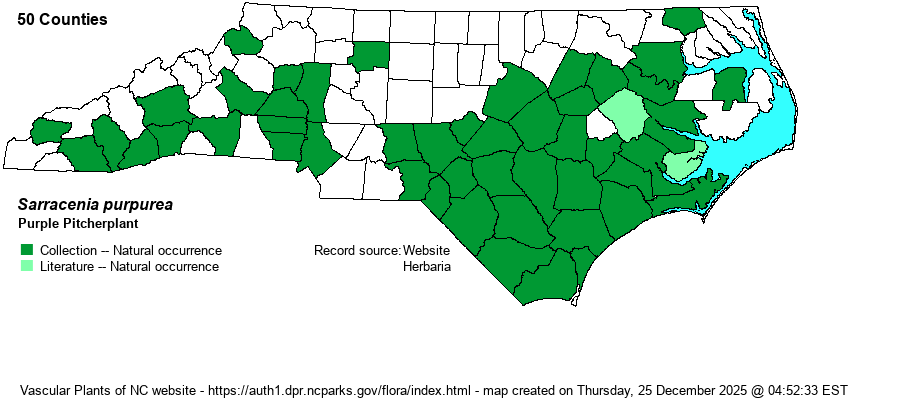| Author | L. | |
| Distribution | Present over all of the southern two-thirds of the Coastal Plain, but very spotty in the northeastern counties. Scattered in the southern Piedmont, north (formerly) to Forsyth County, and also scattered over most of the Mountains. Certainly absent over most of the northern Piedmont.
This species has a very odd range, like few other species. It ranges across most of Canada, and then in a triangular wedge southward in the eastern U.S. That is, it ranges from ME to MN, but southward mostly to the Great Lakes, and then mainly on the Atlantic seaboard, south to southern GA. Though it occurs in much of the NC and VA mountains, the BONAP map and Weakley's (2024) map show no records for KY or TN. | |
| Abundance | Fairly common, at least locally, from the Sandhills eastward to Croatan National Forest in Craven and Carteret counties. Uncommon at best north of that region in the Coastal Plain, and probably absent in the extreme northeastern corner. Rare and local in the southern Piedmont, as well as in most of the central and southern Mountains. Very rare in the northern Mountains, and recently (in May 2021) this taxon -- S. purpurea var. montana -- was listed as State Endangered. | |
| Habitat | In the southern Coastal Plain it occurs mostly in the wetter part of savannas, and in adjacent swales and scrapes. Farther inland, it is mostly found in seepages and streamheads in the Sandhills and southern Piedmont, and in bogs and seepages in the Mountains. As it often is found in seepages, it has a tendency to be found in much smaller wetlands than other Sarracenia species. |
| Phenology | Blooms in April and May in the Coastal Plain and southeastern Piedmont (var. venosa), but generally in May in the Mountains and western Piedmont (var. montana). The plants fruit 1-2 months after flowering. | |
| Identification | Though it resembles one or two other pitcherplant species outside of NC, within the state it is unique and very easily identified, and it is the only one in the state with evergreen leaves. Each plant has several leaves generally sprawling in a horizontal or diagonal direction near the ground, instead of rising vertically like the other species in the genus. Each leaf forms a very broad and inflated pitcher, about 4-5 inches long, with a widely flared rim or hood that leaves the mouth of the pitcher quite open. The leaves usually are quite red-tinged. The flower stalk, separate from the pitchers, grows about 9-12 inches tall, with a single rather large maroon-purple flower. The flower droops, and consists of a maroon disk and 5 petals of the same color, each about 2 inches long, hanging downward like in other species. It often grows with S. rubra, and each has maroon flowers, but the pitchers are of different shapes, and S. rubra flowers are smaller and more cubical in shape as opposed to spherical. The species can easily "hide" in savannas and seepages, and observers need to move slowly through its habitat to spot them, except when the flowers are in bloom. | |
| Taxonomic Comments | This has always been a good species, but various references split it into a few varieties. The nominate variety does not even occur in NC. As mentioned above, the form in the Coastal Plain and the eastern Piedmont is S. purpurea var. venosa; the form in the Mountains and the Piedmont east to Iredell and Alexander counties is S. purpurea var. montana, according to Weakey (2018).
| |
| Other Common Name(s) | Northern Pitcherplant. A few other names listed in Wikipedia -- Turtle Socks and Side-saddle Flower -- are silly and seldom used, and certainly not found in a respected reference! Weakley (2018) names the western NC taxon as the Southern Appalachian Purple Pitcherplant, and the eastern NC taxon as the Southern Purple Pitcherplant. | |
| State Rank | S3 [S3S4] | |
| Global Rank | G5 | |
| State Status | | |
| US Status | | |
| USACE-agcp | OBL link |
| USACE-emp | OBL link |

